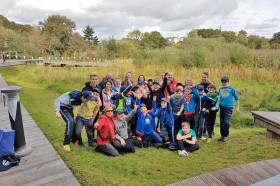Displaying items by tag: River Explorers
River Explorers Programme Expanded & Fully Booked For 2019
Waterways Ireland and Leave No Trace Ireland are working in partnership again to deliver their River Explorers programme.
River Explorers engages local primary school children to take pride in their local river, lake or canal.
Funding was successfully secured during 2018 to run the programme from a number of local authorities including Cavan, Longford, Fingal, Kilkenny, Limerick and Clare.
The programme runs throughout February and March, and for 2019 increases from 17 to 20 days given the additional level of funding secured.
The programme will be taking place at the 12th Lock in Castleknock and Richmond Harbour, Clondra on the Royal Canal; Twomilegate on the Shannon; Ballyconnell on the Shannon-Erne Waterway; and Graiguenamanagh on the Barrow.
Waterways Ireland says schools have been “very eager” to participate in the programme, with all available sessions now fully booked.
River Explorers is a one-day programme which aims to enable participants to become aware of the geographical location, leisure potential and biodiversity value of their local river, lake or canal through outdoor and hands-on learning, skills training, resource development and raising public awareness.
“Creating positive memories, healthy lifestyles, and physical wellbeing as well as paving the way for creating opportunities for caring for our natural heritage are all integral facets of a project that has sustainability at its core,” says Waterways Ireland.
“This project will empower primary school students to connect with their natural environment and enjoy their natural heritage responsibly and ethically.”
Each participating school group will take part in classroom-based sessions in the morning followed by outdoor sessions in the afternoon at their local waterway.
“The idea in the morning session is to impart the knowledge and skills the participants need to understand how to identify the wealth of biodiversity on the local rivers and canals, be able to anticipate how their use of these waterways impacts on this and the measures they can take to minimise this impact,” the organisers explain.
“The afternoon session is about putting the knowledge and skills learned in the classroom into practice. Students will have the opportunity to discover the vast array of wildlife that calls the inland waterways their home.
“Each group will learn how to identify some of the plants and trees along canal and river banks and even come face to face with some mini-beasts living in these ecosystems.
“Leave No Trace Ireland and Waterways Ireland are delighted to partner in the delivery of what promises to be an excellent education programme.”























